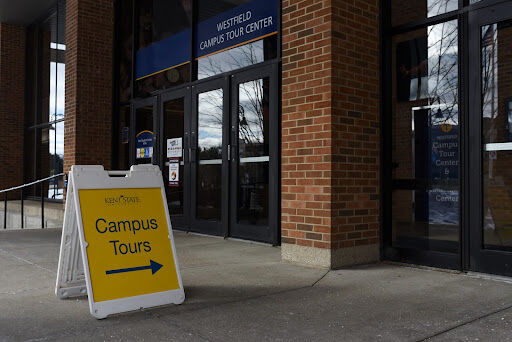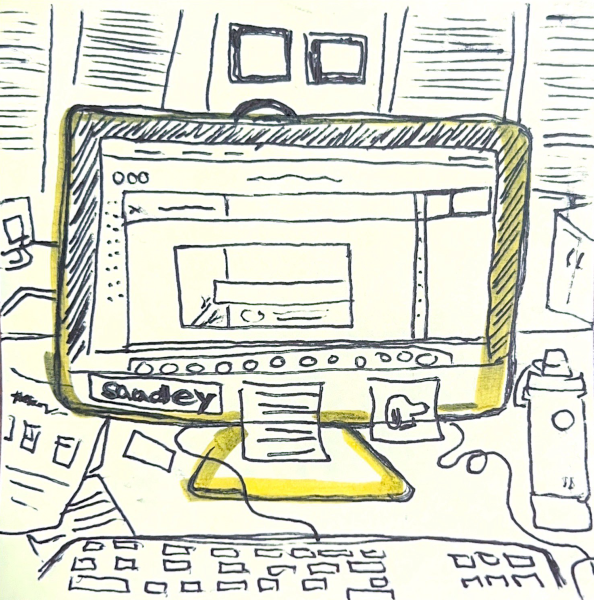Tour guides threat to strike for higher pay and better treatment results in resolution with university admissions

Groups could previously schedule campus tours anytime, but admissions changed the parameters to limit the tours for certain days when more guides work. The university schedules about 46 monthly tours for individuals and groups, including high school seniors and prospective students and families.
January 23, 2022
What started out as a list of concerns turned into demands from student tour guides ready to strike. A call to change communication issues, inequitable student wages and what escalated the situation – the firing of lead tour guide Joseph Albanese – were among the requests.
In an anonymous poll, 27 out of 30 tour guides voted in favor to stop work if necessary. Charlie Coward, a lead tour guide who emailed the demands to the team’s supervisor, said the nearly-unanimous vote for work stoppage could be a burden for some.
“There were a couple people that indicated that they were either unwilling or financially unable to strike,” Coward said. “Obviously, [for] some people this is their only job. I didn’t want to put anybody in a financially compromising situation.”
But with 90 percent of the student workers willing to forfeit pay, demands were sent. In the email, the team gave a deadline for response before preparing to strike.
“We have agreed to give admissions one week to set up a meeting with ALL GUIDES PRESENT to go over our concerns, the list of demands, and what the admissions staff will do to acknowledge and alleviate our concerns,” Coward wrote. “If no action is taken by Tuesday, November 23, all tour guides will hereby go on strike starting Wednesday, November 24. We will not be returning to work until our demands are met.”
On Nov. 22 2021, about 30 students poured into the tour center with four admissions faculty members ready to negotiate.
Sean Broghammer, the interim vice president of enrollment management, co-led the meeting.
The group “talked through what was happening, and people were able to share their experience. … We did not go necessarily step by step through the demands,” he said. “To me they kind of revolved around a couple specific themes.”
The meeting kicked-off with the topic of low wages compared to other student jobs on campus. Broghammer added that students felt mistreated by admissions staff on event days, and they were concerned about the handling of a peer’s employment.
He acknowledged that wages fell behind other campus employers like dining services and because of the role’s demand, students felt they “should be paid appropriately.”
Students left the meeting divided on its resolution.
“I think that actual changes are gonna come from this, but a lot of people were still very, very angry after that meeting so I think it was definitely a split house of how well we thought the meeting went,” Coward said.
In a Dec. 6 meeting, the guide’s supervisor announced some of the changes. Tour guides hourly compensation increased from $9 to $10.50 and lead guides from $10 to $11.50. Saturday shifts are available for sign-ups, more breaks are included on event days, and a conversation form and personal time-off sheet is now used.
The backstory leading up to the potential strike answers more of the why.
Most of the students were hired during the pandemic, when tours were down. But when the numbers imploded last summer and into the fall semester, Coward said the tour guides felt overworked and underappreciated.
Only 10 families a day could tour the university during the 2020 spring semester, but Broghammer said guides gave an average of three per day. In fall of 2021, the cap lifted.
“It presents very differently,” he added. “The job is even different I think than people may have expected.”
Last fall, the admissions office tried “to hire more tour guides,” he continued. “It’s tough to find people.”
Student employment was down about 300 during the fall, and the shortage could continue into this semester.
The strike process
While the guides threatened to strike, a question was asked. Can students strike? The answer is no.
Striking is equivalent to protesting from the university’s standpoint. By “striking” and not reporting to work, it’s the same as not showing up for a scheduled shift. Upon return, job security isn’t guaranteed.
“Student employees don’t have a protection like a union,” said Keith Smith, the associate director of Career Exploration & Development. “A union has some rights because they’ve collectively bargained with the company and entered into an agreement to establish wages and benefits across the organization.”
Kent State employees fall under the Ohio Administrative Code 3358:17-9-03, which reads that support staff, regularly scheduled part-time and casual labor are employed on an at-will basis. Either they or the college may end the employment relationship with or without notice and with or without cause.
Along with Ohio law, “there’s no policy at Kent State on students striking,” Smith added. “There’s no legal ramification.” Meaning, a contract doesn’t bind the university to uphold a strike and keep employment. That’s how a union operates.
The grievance process
But there’s still help for students with unresolved conflict. Student Ombuds, which assists with university-related concerns for those who want counsel, provides options like filing a grievance.
Amy Quillen, ombuds facilitator, “serves as a resource for students and other members of the university community regarding any complaint, grievance or appeal that may be academic or non-academic in nature,” she wrote on ombuds website.
The office also provides consultation related to Kent State’s policies and procedures. Career Exploration & Development receives the grievances.
“I walk them (students) through what a grievance means, how to resolve the situation or how to handle the situation [and] what steps they can take to move forward,” Smith said.
Career Exploration & Development also offers career communities that house career advisors, student peers, who help with resumes and handshake navigation, and professional development opportunities for students seeking employment. Albanese, the former lead guide, is working with an advisor.
“I am moving onto different opportunities and Career Exploration & Development is kind of helping guide me and giving me some opportunities, which I find fantastic,” he said.
The resolution process
As students and faculty negotiated the list of demands, there is still work to do.
This semester, training is revised to reflect the changes, with an emphasis on better communication. The conversation form, which allows the guides to offer anonymous feedback to their supervisor, will be reintroduced.
“There’s a renewed focus on spring training so the team in January will come back, and we’re laying out some new, just revised and kind of more clear expectations,” Broghammer said. “And also opening up communication channels.
Coward said their “biggest sticking point” was poor communication.
“I sense that changing, at least from my perspective so I hope that that continues to change.”
Misinformation played into the communication disconnect so now the direct supervisor meets more often with guides. Eliminating the spread of wrong information is a work in progress.
Kelly Krabill is managing editor. Contact her at [email protected].




















